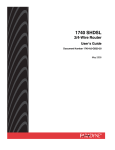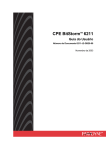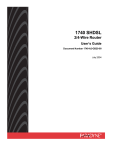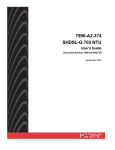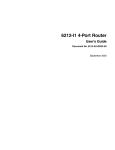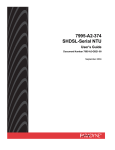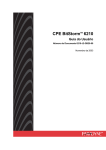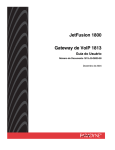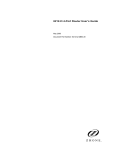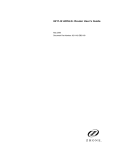Download Zhone 6211 User`s guide
Transcript
6211-I1 ADSL2+ Router User’s Guide Document Number 6211-A2-GB21-20 January 2005 6211 ADSL2+ Router User’s Guide Copyright © 2005 Paradyne Corporation. All rights reserved. Printed in U.S.A. Notice This publication is protected by federal copyright law. No part of this publication may be copied or distributed, transmitted, transcribed, stored in a retrieval system, or translated into any human or computer language in any form or by any means, electronic, mechanical, magnetic, manual or otherwise, or disclosed to third parties without the express written permission of Paradyne Corporation, 8545 126th Ave. N., Largo, FL 33773. Paradyne Corporation makes no representation or warranties with respect to the contents hereof and specifically disclaims any implied warranties of merchantability or fitness for a particular purpose. Further, Paradyne Corporation reserves the right to revise this publication and to make changes from time to time in the contents hereof without obligation of Paradyne Corporation to notify any person of such revision or changes. Changes and enhancements to the product and to the information herein will be documented and issued as a new release to this manual. Warranty, Sales, Service, and Training Information Contact your local sales representative, service representative, or distributor directly for any help needed. For additional information concerning warranty, sales, service, repair, installation, documentation, training, distributor locations, or Paradyne worldwide office locations, use one of the following methods: Internet: Visit the Paradyne World Wide Web site at www.paradyne.com. (Be sure to register your warranty at www.paradyne.com/warranty.) Telephone: Call our automated system to receive current information by fax or to speak with a company representative. Within the U.S.A., call 1-800-870-2221 Outside the U.S.A., call 1-727-530-2340 Document Feedback We welcome your comments and suggestions about this document. Please mail them to Technical Publications, Paradyne Corporation, 8545 126th Ave. N., Largo, FL 33773, or send e-mail to [email protected]. Include the number and title of this document in your correspondence. Please include your name and phone number if you are willing to provide additional clarification. Trademarks Acculink, Comsphere, ETC, Etherloop, FrameSaver, GranDSLAM, Hotwire, the Hotwire logo, Jetstream, MVL, NextEDGE, OpenLane, Paradyne, the Paradyne logo, Paradyne Credit Corp., the Paradyne Credit Corp. logo, Performance Wizard, StormPort, TruPut are all registered trademarks of Paradyne Corporation. ADSL/R, BitStorm, Connect to Success, GrandVIEW, Hotwire Connected, iMarc, JetFusion, JetVision, MicroBurst, PacketSurfer, ReachDSL, Spectrum Manager, StormTracker and TriplePlay are trademarks of Paradyne Corporation. All other products and services mentioned herein are the trademarks, service marks, registered trademarks, or registered service marks of their respective owners. 2 January 2005 6211-A2-GB21-20 6211 ADSL2+ Router User’s Guide Important Safety Instructions 1. Read and follow all warning notices and instructions marked on the product or included in the manual. 2. Slots and openings in the cabinet are provided for ventilation. To ensure reliable operation of the product and to protect it from overheating, these slots and openings must not be blocked or covered. 3. Do not allow anything to rest on the power cord and do not locate the product where persons will walk on the power cord. 4. Do not attempt to service this product yourself, as opening or removing covers may expose you to dangerous high voltage points or other risks. Refer all servicing to qualified service personnel. 5. General purpose cables are used with this product for connection to the network. Special cables, which may be required by the regulatory inspection authority for the installation site, are the responsibility of the customer. Use a UL Listed, CSA certified, minimum No. 24 AWG line cord for connection to the Digital Subscriber Line (DSL) network. 6. When installed in the final configuration, the product must comply with the applicable Safety Standards and regulatory requirements of the country in which it is installed. If necessary, consult with the appropriate regulatory agencies and inspection authorities to ensure compliance. 7. A rare phenomenon can create a voltage potential between the earth grounds of two or more buildings. If products installed in separate buildings are interconnected, the voltage potential may cause a hazardous condition. Consult a qualified electrical consultant to determine whether or not this phenomenon exists and, if necessary, implement corrective action prior to interconnecting the products. 8. Input power to this product must be provided by one of the following: (1) a UL Listed/CSA certified power source with a Class 2 or Limited Power Source (LPS) output for use in North America, or (2) a certified transformer, with a Safety Extra Low Voltage (SELV) output having a maximum of 240 VA available, for use in the country of installation. 9. In addition, since the equipment is to be used with telecommunications circuits, take the following precautions: — Never install telephone wiring during a lightning storm. — Never install telephone jacks in wet locations unless the jack is specifically designed for wet locations. — Never touch uninsulated telephone wires or terminals unless the telephone line has been disconnected at the network interface. — Use caution when installing or modifying telephone lines. — Avoid using a telephone (other than a cordless type) during an electrical storm. There may be a remote risk of electric shock from lightning. — Do not use the telephone to report a gas leak in the vicinity of the leak. CE Marking When the product is marked with the CE mark on the equipment label, a supporting Declaration of Conformity may be downloaded from the Paradyne World Wide Web site at www.paradyne.com. Select Support -> Technical Manuals -> Declarations of Conformity. 6211-A2-GB21-20 January 2005 3 6211 ADSL2+ Router User’s Guide FCC Part 15 Declaration An FCC Declaration of Conformity may be downloaded from the Paradyne World Wide Web site at www.paradyne.com. Select Support -> Technical Manuals -> Declarations of Conformity. This device complies with Part 15 of the FCC Rules. Operation is subject to the following two conditions: (1) this device may not cause harmful interference, and (2) this device must accept any interference received, including interference that may cause undesired operation. The authority to operate this equipment is conditioned by the requirement that no modifications will be made to the equipment unless the changes or modifications are expressly approved by the responsible party. This equipment has been tested and found to comply with the limits for a Class B digital device, pursuant to Part 15 of the FCC Rules. These limits are designed to provide reasonable protection against harmful interference in a residential installation. This equipment generates, uses, and can radiate radio frequency energy and, if not installed and used in accordance with the instructions, may cause harmful interference to radio communications. However, there is no guarantee that interference will not occur in a particular installation. If this equipment does cause harmful interference to radio or television reception, which can be determined by turning the equipment off and on, the user is encouraged to try to correct the interference by one or more of the following measures: • Reorient or relocate the receiving antenna. • Increase the separation between the equipment and receiver. • Connect the equipment into an outlet on a circuit different from that to which the receiver is connected. • Consult the dealer or an experienced radio/TV technician for help. Notice to Users of the United States Telephone Network The following notice applies to versions of the modem that have been FCC Part 68 approved. This equipment complies with Part 68 of the FCC rules and the requirements adopted by the Administrative Council for Terminal Attachment (ACTA). On the bottom side of this equipment is a label that contains, among other information, a product identifier in the format US:AAAEQ##TXXXX. If requested, this number must be provided to the Telephone Company. This equipment is intended to connect to the Public Switched Telephone Network through a Universal Service Order Code (USOC) type RJ11C jack. A plug and jack used to connect this equipment to the premises wiring and telephone network must comply with the applicable FCC Part 68 rules and requirements adopted by the ACTA. A compliant telephone cord and modular plug is provided with this product. It has been designed to be connected to a compatible modular jack that is also compliant. The Ringer Equivalence Number (or REN) is used to determine the number of devices that may be connected to a telephone line. Excessive RENs on a telephone line may result in the devices not ringing in response to an incoming call. In most but not all areas, the sum of RENs should not exceed five (5.0). To be certain of the number of devices that may be connected to a line, as determined by the total RENs, contact the local Telephone Company. The REN for this product is part of the product identifier that has the format US:AAAEQ##TXXXX. The digits represented by ## are the REN without a decimal point. For example, 03 represents a REN of 0.3. If the modem causes harm to the telephone network, the Telephone Company will notify you in advance that temporary discontinuance of service may be required. But if advance notice is not practical, the Telephone Company will notify the customer as soon as possible. Also, you will be advised of your right to file a complaint with the FCC if you believe it is necessary. The Telephone Company may make changes in its facilities, equipment, operations or procedures that could affect the operation of the equipment. If this happens, the Telephone Company will provide advance notice in order for you to make necessary modifications to maintain uninterrupted service. If trouble is experienced with the modem, refer to the repair and warranty information in this document. If the equipment is causing harm to the telephone network, the Telephone Company may request that you disconnect the equipment until the problem is resolved. 4 January 2005 6211-A2-GB21-20 6211 ADSL2+ Router User’s Guide The user may make no repairs to the equipment. Connection to party line service is subject to state tariffs. Contact the state public utility commission, public service commission or corporation commission for information. If the site has specially wired alarm equipment connected to the telephone line, ensure the installation of the modem does not disable the alarm equipment. If you have questions about what will disable alarm equipment, consult your Telephone Company or a qualified installer. Notice to Users of the Canadian Telephone Network NOTICE: This equipment meets the applicable Industry Canada Terminal Equipment Technical Specifications. This is confirmed by the registration number. The abbreviation IC before the registration number signifies that registration was performed based on a Declaration of Conformity indicating that Industry Canada technical specifications were met. It does not imply that Industry Canada approved the equipment. NOTICE: The Ringer Equivalence Number (REN) for this terminal equipment is labeled on the equipment. The REN assigned to each terminal equipment provides an indication of the maximum number of terminals allowed to be connected to a telephone interface. The termination on an interface may consist of any combination of devices subject only to the requirement that the sum of the Ringer Equivalence Numbers of all the devices does not exceed five. If your equipment is in need of repair, contact your local sales representative, service representative, or distributor directly. CANADA – EMI NOTICE: This Class B digital apparatus meets all requirements of the Canadian interference-causing equipment regulations. Cet appareil numérique de la classe B respecte toutes les exigences du règlement sur le matérial brouilleur du Canada. Japan Notices 6211-A2-GB21-20 January 2005 5 6211 ADSL2+ Router User’s Guide 6 January 2005 6211-A2-GB21-20 6211 ADSL2+ Router User’s Guide Table of Contents 1 INTRODUCTION ...........................................................................................................................................9 FEATURES ........................................................................................................................................................................9 SYSTEM REQUIREMENTS .................................................................................................................................................9 USING THIS DOCUMENT...................................................................................................................................................9 2 GETTING TO KNOW THE 6211 ADSL ROUTER................................................................................11 PARTS LIST.....................................................................................................................................................................11 FRONT PANEL ................................................................................................................................................................12 REAR PANEL ..................................................................................................................................................................13 3 GETTING STARTED...................................................................................................................................14 CONNECTING THE HARDWARE ......................................................................................................................................14 INSTALLING USB DRIVERS ...........................................................................................................................................16 CONFIGURING YOUR COMPUTERS ................................................................................................................................18 LOGGING IN TO YOUR ROUTER.......................................................................................................................................22 4 DEVICE INFORMATION...........................................................................................................................24 SUMMARY ......................................................................................................................................................................24 WAN..............................................................................................................................................................................25 STATISTICS .....................................................................................................................................................................26 ADSL STATISTICS .........................................................................................................................................................29 ROUTE ............................................................................................................................................................................30 ARP ...............................................................................................................................................................................31 5 QUICK SETUP ..............................................................................................................................................32 AUTO PVC.....................................................................................................................................................................32 SETTING A PVC WITHOUT AUTO DETECTING ...............................................................................................................34 6 ADVANCED SETUP.....................................................................................................................................35 WAN..............................................................................................................................................................................35 LAN...............................................................................................................................................................................41 NAT...............................................................................................................................................................................41 FIREWALL ......................................................................................................................................................................47 QUALITY OF SERVICE ....................................................................................................................................................54 ROUTING ........................................................................................................................................................................57 DNS ...............................................................................................................................................................................61 ADSL.............................................................................................................................................................................62 7 DIAGNOSTICS..............................................................................................................................................65 6211-A2-GB21-20 January 2005 7 6211 ADSL2+ Router User’s Guide 8 MANAGEMENT ...........................................................................................................................................66 SETTINGS........................................................................................................................................................................66 SYSTEM LOG ..................................................................................................................................................................72 ACCESS CONTROL..........................................................................................................................................................76 UPDATE SOFTWARE .......................................................................................................................................................80 REBOOT ROUTER ...........................................................................................................................................................81 8 January 2005 6211-A2-GB21-20 6211 ADSL2+ Router User’s Guide 1 Introduction Congratulations on becoming the owner of a 6211 ADSL router. This User Manual will show you how to set up the router, and how to customize its configuration to get the most out of this product. Features Built-in ADSL modem which offers G.Dmt, G.lite, T1.413, ADSL2, Annex L, and ADSL2+ to meet different linking speeds from your ISP. 10/100BaseT Ethernet port to provide Internet connectivity to all computers on your LAN via additional Ethernet Switch/HUB. USB port allows quick installation. Built-in splitter provides you to connect telephone directly without using extra splitter (Model 6211-I1-x0x). Configuration program accessible via a web browser, such as Microsoft Internet Explorer. Note that Netscape is not supported. System Requirements In order to use the 6211 ADSL router for Internet access, you must have the following: ADSL service subscription from your ISP. A PC with: An Ethernet 10/100BaseT network interface card or USB port A processor equivalent to or faster than a Pentium II 133 MHz 32 MB RAM or greater If USB drivers will be installed, 5 MB free disk space Windows 95b, 98, 98SE, 2000, ME, NT, or XP (Note: Windows 95 requires the installation of the Winsock program, not included. Windows 95 and 98 do not support USB.) (Optional) An Ethernet hub or switch, if you wish to connect the router to several computers on an Ethernet network. For system configuration using the supplied web-based program: a web browser such as Internet Explorer Version 6.0 or later. Using this Document Notational conventions The terms LAN and network are used interchangeably to refer to a group of Ethernet-connected computers at one site. Typographical conventions Boldface type text is used for items you select from menus and drop-down lists, and text strings you type when prompted by the program. 6211-A2-GB21-20 January 2005 9 6211 ADSL2+ Router User’s Guide Special messages This document uses the following icons to call your attention to specific instructions or explanations. Provides clarification or non-essential information on the current topic. Note Provides messages of high importance, including messages relating to personal safety or system integrity. WARNING 10 January 2005 6211-A2-GB21-20 6211 ADSL2+ Router User’s Guide 2 Getting to Know the 6211 ADSL Router Parts List In addition to this document, your 6211 ADSL router should come with the following: 6211 ADSL router Power adapter Ethernet cable (RJ45, “straight-through” type), Phone cable (RJ11), and USB cable. Figure 2-1 6211 ADSL router Package Contents 6211-A2-GB21-20 January 2005 11 6211 ADSL2+ Router User’s Guide Front Panel The front panel contains LED indicators that show the status of the unit. Figure 2-2 Front Panel LEDs Table 2-1 Front Panel Label and LEDs Label Color Function POWER green On: Unit is powered on Off: Unit is powered off STATUS green On: ADSL link is established and active Flashing: Trying to create an ADSL connection Off: No ADSL link ACTIVITY green Flashing: ADSL data transfer LAN green USB green On: LAN link is established Flashing: Data transfer at LAN connection Off: No LAN link On: USB link is established Off: No USB link 12 January 2005 6211-A2-GB21-20 6211 ADSL2+ Router User’s Guide Rear Panel The rear panel contains the ports for the router's data and power connections. Figure 2-3 Rear Panel Connections Table 2-2 Rear Panel Labels and Connectors Label Function POWER Connects to the supplied power adapter RESET/DEFAULT To reset the router to its default settings LAN Connects the CPE to your PC's Ethernet port, or to the uplink port on your LAN's hub or switch, using the cable provided USB USB outlet, for PC USB port connection PHONE Connects to your telephone (Model 6211-I1-x0x) LINE 6211-A2-GB21-20 Connects to your ADSL line January 2005 13 6211 ADSL Router User’s Guide 3 Getting Started This chapter provides basic instructions for connecting the 6211 ADSL router to a PC or LAN, and to the Internet via ADSL. Part 1 provides instructions to set up the hardware. Part 2 describes how to configure Internet properties on your PC. Part 3 shows you how to access your 6211 ADSL router. It is assumed that you have subscribed to ADSL service with your Internet service provider (ISP). These instructions provide a basic configuration that should be compatible with your home or small office network setup. Refer to the subsequent chapters for additional configuration instructions. Connecting the Hardware This section describes how to attach the router to an ADSL line, the power outlet, and your computer or network. WARNING Before you begin, turn the power off for all devices. These include your computer(s), your LAN hub or switch (if applicable), and the 6211 ADSL router. RESET LINE PHONE USB LAN DEFAULT 1 2 3 POWER 4 OR 04-17510 The figure above illustrates the hardware connections. Read the following for specific instructions. 14 January 2005 6211-A2-GB21-20 6211 ADSL2+ Router User’s Guide Connect the ADSL Line and Telephone Connect your ADSL line to the LINE port on the rear panel of the router, and connect the other end of the line to the wall phone jack. Optionally connect your telephone to the port labeled PHONE on the rear panel of the router (Model 6211-I1-x0x only). Connect the computers, USB port, or a LAN There are several ways to connect your PC to the router: You can use the supplied Ethernet cable to connect your computer directly to the router. Connect one end of the Ethernet cable to the port labeled LAN on the rear panel of the router and connect the other end to the Ethernet port of your computer. Alternatively, use the supplied USB cable to connect your computer directly to the router. Connect one end (Type B) of the USB cable to the USB port on the rear panel of the router and connect the other end (Type A) to a free USB port on your PC. The Found New Hardware Wizard will open on your PC. See Installing USB Drivers, below. If your LAN has more than one computer, you can attach one end of an Ethernet cable to a hub or a switch (normally in an uplink port; refer to your hub or switch documentation for instructions) and the other to the Ethernet port (labeled LAN) on the router. Note that either a crossover or straight-through Ethernet cable can be used. The router automatically senses the type of connection that is required. Connect the power adapter Connect the AC power adapter to the POWER connector on the back of the device and plug the adapter into a wall outlet or power strip. Turn on your computer Turn on and boot up your PC and any LAN devices, such as hub or switches, and any computers connected to them. Verify that the router’s LEDs are illuminated as shown in Table 3-1. Table 3-1 LED Indicators This LED: ...should be: POWER Solid green to indicate that the device is turned on. If this light is not on, check if the power adapter is attached to the router and plugged into an AC power source. STATUS Solid green to indicate that the router can communicate with your ISP via ADSL, or flashing when the router is trying to connect to your ISP. ACTIVITY Flashing when the device is sending or receiving data over the ADSL connection. LAN Solid green to indicate that the device can communicate with your PC via Ethernet, or flashing when the router is sending or receiving data over Ethernet. USB Solid green when connected, flashing when the router is sending or receiving data. If the LEDs are illuminated as expected, the router is working properly. 6211-A2-GB21-20 January 2005 15 6211 ADSL2+ Router User’s Guide Installing USB Drivers As soon as you connect the USB cable between your PC and device, Windows will detect new hardware and the Found New Hardware Wizard will appear on your PC monitor. Follow this procedure: 1. Choose “Install from a list or specific location” from the Wizard’s menu, then click on Next. Figure 3-1 Found New Hardware Wizard 2. Insert the supplied CD ROM and use “Browse” to include the CD drive in the search. Figure 3-2 Search and Installation Options 16 January 2005 6211-A2-GB21-20 6211 ADSL2+ Router User’s Guide 3. The Wizard will ask you to confirm the hardware installation. Choose ”Continue Anyway” then it will start to install the supplied USB driver to your PC automatically. Figure 3-3 Compatibility Warning Figure 3-4 Progress Screen 4. When prompted, click on Finish to close the Wizard. Figure 3-5 Completion Screen 6211-A2-GB21-20 January 2005 17 6211 ADSL2+ Router User’s Guide Configuring Your Computers Before you can access the router over the LAN or the USB port, you have to configure your PC’s TCP/IP address to be 192.168.1.x (where x is any number between 3 and 254), with a subnet mask of 255.255.255.0. Your router’s default IP address is 192.168.1.1. Windows XP PCs: 1. In the Windows task bar, click on the Start button, and then click on Control Panel. 2. Double-click on the Network Connections icon. 3. In the LAN or High-Speed Internet window, right-click on the icon corresponding to your network interface card (NIC) or USB connection, and select Properties. (Often this icon is labeled Local Area Connection). The Local Area Connection dialog box displays with a list of currently installed network items. 4. Ensure that the check box to the left of the item labeled Internet Protocol (TCP/IP) is checked, and click on . Figure 3-6 Network Connection - Windows XP Figure 3-7 Local Area Connection Property – Windows XP 18 January 2005 6211-A2-GB21-20 6211 ADSL2+ Router User’s Guide 5. In the Internet Protocol (TCP/IP) Properties dialog box, click on the radio button labeled Use the following IP address. Type an address between 192.168.1.3 and 192.168.1.254 in the IP Address field (192.168.1.20 is shown here as an example) and 255.255.255.0 in the Subnet Mask field. Figure 3-8 TCP/IP Property in Windows XP 6. Click on twice to confirm your changes, and close the Control Panel. Windows 2000 PCs: 7. In the Windows task bar, click on the Start button, point to Settings, and then click on Control Panel. 8. Double-click on the Network and Dial-up Connections icon. 9. In the Network and Dial-up Connections window, right-click on the Local Area Connection icon, and then select Properties. The Local Area Connection Properties dialog box display a list of currently installed network components. If the list includes Internet Protocol (TCP/IP), the protocol has already been enabled; skip to step 16 . 10. If Internet Protocol (TCP/IP) does not appear as an installed component, click on . 11. In the Select Network Component Type dialog box, select Protocol, and then click on . 12. Select Internet Protocol (TCP/IP) in the Network Protocols list, and then click on . You may be prompted to install files from your Windows 2000 installation CD or other medium. Follow the instructions to install the files. 13. If prompted, click on to restart your computer with the new settings. 14. After restarting your PC, double-click on the Network and Dial-up Connections icon in the Control Panel. 15. In Network and Dial-up Connections window, right-click on the Local Area Connection icon, and then select Properties. 6211-A2-GB21-20 January 2005 19 6211 ADSL2+ Router User’s Guide 16. In the Local Area Connection Properties dialog box, select Internet Protocol (TCP/IP), and then . click on 17. In the Internet Protocol (TCP/IP) Properties dialog box, click on the radio button labeled Use the following IP address. Type an address between 192.168.1.3 and 192.168.1.254 in the IP Address field and 255.255.255.0 in the Subnet Mask field. twice to confirm and save your changes, and then close the Control Panel. 18. Click on Windows ME PCs 1. In the Windows task bar, click on the Start button, point to Settings, and then click on Control Panel. 2. Double-click on the Network and Dial-up Connections icon. 3. In the Network and Dial-up Connections window, right-click on the Network icon, and then select Properties. The Network Properties dialog box displays a list of currently installed network components. If the list includes Internet Protocol (TCP/IP), the protocol has already been enabled; skip to step 11. . 4. If Internet Protocol (TCP/IP) does not appear as an installed component, click on 5. In the Select Network Component Type dialog box, select Protocol, and then click on 6. Select Microsoft in the Manufacturers box. 7. Select Internet Protocol (TCP/IP) in the Network Protocols list, and then click on . . You may be prompted to install files from your Windows Me installation CD or other media. Follow the instructions to install the files. to restart your computer with the new settings. 8. If prompted, click on 9. After restarting your PC, double-click on the Network and Dial-up Connections icon in the Control Panel. 10. In Network and Dial-up Connections window, right-click on the Network icon, and then select Properties. 11. In the Network Properties dialog box, select TCP/IP, and then click on . 12. In the TCP/IP Settings dialog box, click on the radio button labeled Use the following IP address. Type an address between 192.168.1.3 and 192.168.1.254 in the IP Address field and 255.255.255.0 in the Subnet Mask field 13. Click twice to confirm and save your changes, and then close the Control Panel. Windows 95, 98 PCs: 1. In the Windows task bar, click on the Start button, point to Settings, and then click on Control Panel. 2. Double-click on the Network icon. The Network dialog box displays a list of currently installed network components. If the list includes TCP/IP, the protocol has already been enabled. Skip to step 9. 3. If TCP/IP does not appear as an installed component, click on Component Type dialog box appears. 4. Select Protocol, and then click on . The Select Network . The Select Network Protocol dialog box appears. 20 January 2005 6211-A2-GB21-20 6211 ADSL2+ Router User’s Guide 5. Click on Microsoft in the Manufacturers list box, and then click on TCP/IP in the Network Protocols list box. 6. Click on to return to the Network dialog box, and then click on again. You may be prompted to install files from your Windows 95/98 installation CD. Follow the instructions to install the files. to restart the PC and complete the TCP/IP installation. 7. Click on 8. After restarting your PC, open the Control Panel window, and then click on the Network icon. 9. Select the network component labeled TCP/IP, and then click on . If you have multiple TCP/IP listings, select the listing associated with your network card or adapter. 10. In the TCP/IP Properties dialog box, click on the IP Address tab. 11. Click in the radio button labeled Use the following IP address. Type an address between 192.168.1.3 and 192.168.1.254 in the IP Address field and 255.255.255.0 in the Subnet Mask field 12. Click on twice to confirm and save your changes. You will be prompted to restart Windows. Please click on and restart your PC. Windows NT 4.0 workstations: 1. In the Windows NT task bar, click on the Start button, point to Settings, and then click on Control Panel. 2. In the Control Panel window, double click on the Network icon. 3. In the Network dialog box, click on the Protocols tab. The Protocols tab displays a list of currently installed network protocols. If the list includes TCP/IP, the protocol has already been enabled. Skip to step 9. . 4. If TCP/IP does not appear as an installed component, click on 5. In the Select Network Protocol dialog box, select TCP/IP, and then click on . You may be prompted to install files from your Windows NT installation CD or other medium. Follow the instructions to install the files. After all files are installed, a window appears to inform you that a TCP/IP service called DHCP can be set up to dynamically assign IP information. 6. Click on computer. 7. After restarting your PC, open the Control Panel window, and then double-click on the Network icon. 8. In the Network dialog box, click on the Protocols tab. 9. In the Protocols tab, select TCP/IP, and then click on to continue, and then click on , if prompted, to restart your . 10. In the Microsoft TCP/IP Properties dialog box, click on the radio button labeled Use the following IP address. Type an address between 192.168.1.3 and 192.168.1.254 in the IP Address field and 255.255.255.0 in the Subnet Mask field. 11. Click on 6211-A2-GB21-20 twice to confirm and save your changes, and then close the Control Panel. January 2005 21 6211 ADSL2+ Router User’s Guide Logging in to your router This section shows how to connect to the router’s web interface, configure settings, and observe some statistics of your Internet connection. 1. Open your Web browser, and type the following URL in the address/location box, and press <Enter>: http://192.168.1.1 This is the predefined IP address for the LAN port on the router. A login screen appears. Figure 3-9 Login Screen If you have problem connecting to the router, verify that your PC is properly configured within the subnet of the router’s predefined IP address 192.168.1.1. Setup is described in sections 3.2.2 to 3.2.6. 2. to display the home page of the Enter your user name and password, and then click on router’s web interface. There are two default user name and password combinations: User Name Password Capability user user Can display device status, but cannot change or save configuration options. admin admin Can perform all functions. You can change the passwords at any time. Note 22 January 2005 6211-A2-GB21-20 6211 ADSL2+ Router User’s Guide The home page is shown in Figure 3-10. Figure 3-10 6211 ADSL Router Home Page 6211-A2-GB21-20 January 2005 23 6211 ADSL2+ Router User’s Guide 4 Device Information This chapter describes the system information available using the menu items under Device Info. Summary You can get the general status report from the router by clicking on the “Summary” item under “Device Info” (shown in Figure 4.1) Figure 4.1 Status Summary 24 January 2005 6211-A2-GB21-20 6211 ADSL2+ Router User’s Guide WAN You can get the WAN status report from the router by clicking on the “WAN” item under “Device Info” (shown in Figure 4.2) Figure 4.2 WAN Status 6211-A2-GB21-20 January 2005 25 6211 ADSL2+ Router User’s Guide Statistics LAN Statistics You can get LAN statistics from the router by clicking on the “LAN” item under “Statistics” (shown in Figure 4.3) Figure 4.3 LAN Statistics Page 26 January 2005 6211-A2-GB21-20 6211 ADSL2+ Router User’s Guide WAN Statistics You can get WAN statistics from the router by clicking on the “WAN” item under “Statistics” (shown in Figure 4.4). Figure 4.4 WAN Statistics Page 6211-A2-GB21-20 January 2005 27 6211 ADSL2+ Router User’s Guide ATM Statistics You can get ATM statistics from the router by clicking on the “ATM” item under “Statistics” (shown in Figure 4.5). Figure 4.5 ATM Statistics Page 28 January 2005 6211-A2-GB21-20 6211 ADSL2+ Router User’s Guide ADSL Statistics You can get ADSL statistics from the router by clicking on the “ADSL” item under “Statistics” (shown in Figure 4.6). Figure 4.6 ADSL Status ADSL BER Test The ADSL Bit Error Rate (BER) test determines the quality of the ADSL connection. The test is performed by transferring idle cells containing a known pattern and comparing the received data with this known pattern to check for any errors (shown in Figures 4.7 and 4.8). 1. Click on the ADSL BER Test button. 2. Select the test duration and click on “Start”. 3. Check the result. Figure 4.7 ADSL BER Test - Start 6211-A2-GB21-20 Figure 4.8 ADSL BER Test - Result January 2005 29 6211 ADSL2+ Router User’s Guide Route You can get the Routing status report from router by clicking on the “Route” item under “Device Info” (shown in Figure 4.9) Figure 4.9 Device Info - Route 30 January 2005 6211-A2-GB21-20 6211 ADSL2+ Router User’s Guide ARP You can get the ARP status report from the router by clicking on the “ARP” item under “Device Info” (shown in Figure 4.10) Figure 4.10 ARP Status 6211-A2-GB21-20 January 2005 31 6211 ADSL2+ Router User’s Guide 5 Quick Setup This chapter guides you through the steps to configure your router. Auto PVC Auto-connect will automatically detect the first usable PVC and automatically detect PPPoE, PPPoA, and Bridge Protocol (with DHCP Server available). 32 January 2005 6211-A2-GB21-20 6211 ADSL2+ Router User’s Guide Figure 5.1 Detecting available PVC Figure 5.2 Detecting available PVC – Available PVC detected 6211-A2-GB21-20 January 2005 33 6211 ADSL2+ Router User’s Guide Setting a PVC without Auto detecting Figure 5.3 Without Auto PVC, the detail setting can reference “Advanced Setup” 34 January 2005 6211-A2-GB21-20 6211 ADSL2+ Router User’s Guide 6 Advanced Setup The chapter contains informations about WAN, LAN, and ADSL settings. WAN Set up WAN parameters as directed by your ISP. Figure 6-1 WAN Setup Page 6211-A2-GB21-20 January 2005 35 6211 ADSL2+ Router User’s Guide Add Function If you want to add a new rule for the WAN interface, click on the “Add” button. The ATM PVC Configuration screen appears. ATM PVC Configuration Screen The ATM PVC Configuration screen allows you to configure an ATM PVC identifier (VPI and VCI) and select a service category. Figure 6-2 ATM PVC Configuration Page Verify the following values with your ISP before you change them. VPI : Virtual Path Identifier. The valid range is 0 to 255. VCI : Virtual Channel Identifier. The valid range is 32 to 65535. Service Category : Five classes of traffic defined are defined: UBR Without PCR. UBR With PCR. CBR. Non Realtime VBR. Realtime VBR. 36 January 2005 6211-A2-GB21-20 6211 ADSL2+ Router User’s Guide Connection Type Screen Select the type of network protocol and encapsulation mode over the ATM PVC that your ISP has instructed you to use, then click on Next button. Figure 6-3 Connection Type Page 6211-A2-GB21-20 January 2005 37 6211 ADSL2+ Router User’s Guide Bridge Service and Quality of Service Screen This WAN service can be enabled or disabled by clicking in the check box. Enabling QoS for a PVC improves performance for selected classes of applications. However, since QoS also consumes system resources, the number of PVCs is reduced. The default setting for QoS is disabled. If you want to enable QoS service, select the “Enable Quality Of Service” check box. After finishing steps as above, click on the Next button. Figure 6-4 Enable Bridge Service 38 January 2005 6211-A2-GB21-20 6211 ADSL2+ Router User’s Guide WAN Setup – Summary Make sure that the settings on the WAN Setup screen match the settings provided by your ISP. If all settings are correct, click on the Save button to save these settings; if not, click on the Back button to make any modifications. If you want to change some items after being finished settings, you also click on the Edit button to make any modifications. Figure 6-5 WAN Setup Summary Note 6211-A2-GB21-20 You need to activate this WAN interface by clicking on the Finish button and further configure services over this interface. The router supports up to five WAN connections. January 2005 39 6211 ADSL2+ Router User’s Guide Remove Function If you want to delete a connection from the listed WAN setup, click in the Remove check box next to the item, then click on the Remove button. Figure 6-6 WAN Setup Finish Function After you change any item in WAN Setup, remember to click on the Finish button to apply the changes and reboot the system. 40 January 2005 6211-A2-GB21-20 6211 ADSL2+ Router User’s Guide LAN Local Area Network (LAN) Setup You can configure the DSL Router IP address and Subnet Mask for the LAN interface to conform your LAN’s IP Subnet. The Save button only saves the LAN configuration data. The Save/Reboot button saves the LAN configuration data and reboots the router to make the new configuration effective. Figure 6-7 LAN Setup NAT You can configure the Virtual Server, Port Triggering, and DMZ Host when NAT is enabled. Virtual Servers A virtual server allows you to direct incoming traffic from the WAN side to a specific IP address on the LAN side. Click on the Add button to add a virtual server. 6211-A2-GB21-20 January 2005 41 6211 ADSL2+ Router User’s Guide Figure 6.8 Virtual Server Setup Page You can select a Service or make new one. Enter the Server IP Address, then click on Save/Apply to submit your configuration. Figure 6.7 Virtual Server Add Page 42 January 2005 6211-A2-GB21-20 6211 ADSL2+ Router User’s Guide On this screen you can view and delete servers. Click in the check box under Remove and click on the Remove button to delete selected virtual servers. Figure 6.8 Virtual Server List 6211-A2-GB21-20 January 2005 43 6211 ADSL2+ Router User’s Guide Port Triggering Click the on the Add button to add Port Triggering for your Internet application. Figure 6.9 Port Triggering Setup Page 44 January 2005 6211-A2-GB21-20 6211 ADSL2+ Router User’s Guide You can select an application every time or create new one for your application. Then click on Save/Apply to save your settings. Figure 6.10 Port Triggering Add Page On this screen you can view and delete applications. Click in the check box under Remove and click on the Remove button to delete selected applications. Figure 6.11 Port Triggering List 6211-A2-GB21-20 January 2005 45 6211 ADSL2+ Router User’s Guide DMZ Host You can define the IP address of the DMZ Host on this screen. Enter the IP address and click on Save/Apply. Figure 6.12 DMZ Host Setup Page 46 January 2005 6211-A2-GB21-20 6211 ADSL2+ Router User’s Guide Firewall IP Filtering Outgoing The outgoing filter will block the traffic from the LAN side to the WAN side. Click on Add to create filters. Figure 6.13 IP Filtering – Outgoing Filtering Setup Page 6211-A2-GB21-20 January 2005 47 6211 ADSL2+ Router User’s Guide Input the filter name, source information (from the LAN side), and Destination information (from the WAN side). Then click on Save/Apply. Figure 6.14 IP Filtering – Outgoing Filtering Add Page You can view and delete the outgoing filter settings on this screen. Figure 6.15 IP Filtering – Outgoing Filtering Setup List 48 January 2005 6211-A2-GB21-20 6211 ADSL2+ Router User’s Guide Incoming Incoming filter filters the traffic from the WAN side to the LAN side. Click on Add to add incoming filter settings. Figure 6.16 IP Filtering – Incoming Filtering Setup Page 6211-A2-GB21-20 January 2005 49 6211 ADSL2+ Router User’s Guide Enter a filter name, information about the source address (from the WAN side), and information about the destination address ( to the LAN side). Select the protocol and WAN interface. Then click on Save/Apply to add the setting. Figure 6.17 IP Filtering – Incoming Filtering Add Page You can view and delete the incoming filter settings from this screen. Figure 6.18 IP Filtering – Incoming Filtering List 50 January 2005 6211-A2-GB21-20 6211 ADSL2+ Router User’s Guide MAC Filtering MAC filtering can forward or block traffic by MAC address. You can change the policy or add settings to the MAC filtering table using the MAC Filtering Setup screen. Figure 6.19 IP Filtering – MAC Filtering Setup Page 6211-A2-GB21-20 January 2005 51 6211 ADSL2+ Router User’s Guide If you click on Change Policy, a confirmation dialog lets you verify your change. Figure 6.20 IP Filtering – MAC Filtering Policy Change Confirmation If you want to add a setting to the MAC filtering table, enter the Source and Destination MAC address, and select protocol type, frame direction, and WAN interface. Then click on Save/Apply to save it. Figure 6.21 IP Filtering – MAC Filtering Add Page 52 January 2005 6211-A2-GB21-20 6211 ADSL2+ Router User’s Guide On this screen you can view and delete MAC filtering rules. Figure 6.22 IP Filtering – MAC Filtering List 6211-A2-GB21-20 January 2005 53 6211 ADSL2+ Router User’s Guide Quality of Service You can configure the Quality of Service to apply different priorities to traffic on the router. Figure 6.23 Quality of Service Setup Page 54 January 2005 6211-A2-GB21-20 6211 ADSL2+ Router User’s Guide Click on Add and the Add Network Traffic Class Rule screen appears. Enter and select QoS parameters, then click on Save/Apply. Figure 6.24 Quality of Service Add Page 802.1p Priority and TOS are mutually exclusive. Note 6211-A2-GB21-20 January 2005 55 6211 ADSL2+ Router User’s Guide On this screen you can view and delete QoS settings. Figure 6.25 Quality of Service List 56 January 2005 6211-A2-GB21-20 6211 ADSL2+ Router User’s Guide Routing Default Gateway You can change the Default Gateway on the Routing – Default Gateway screen. Figure 6.26 Default Gateway Setup Page 6211-A2-GB21-20 January 2005 57 6211 ADSL2+ Router User’s Guide Static Route Use the Routing – Static Route screen to add a static route to the routing table. Figure 6.27 Static Route Setup Page 58 January 2005 6211-A2-GB21-20 6211 ADSL2+ Router User’s Guide Enter the route information and click on Save/Apply to make it active. No reboot is required. Figure 6.28 Static Route Add Page 6211-A2-GB21-20 January 2005 59 6211 ADSL2+ Router User’s Guide RIP If RIP is enabled, the router operation can be configured as Active or Passive. Figure 6.29 RIP Setup Page 60 January 2005 6211-A2-GB21-20 6211 ADSL2+ Router User’s Guide DNS DNS Server Use the DNS Server screen to request automatic assignment of a DNS or to specify a primary and secondary DNS. Figure 6.30 DNS Setup Page 6211-A2-GB21-20 January 2005 61 6211 ADSL2+ Router User’s Guide ADSL There are three major items in the ADSL settings: Modulation Methods Six modulation methods for different linking speed are supported by the 6211 ADSL router: G.Dmt Enabled, G.lite Enabled, T1.413 Enabled, ADSL Enabled, Annex L Enabled, and ADSL2+ Enabled. Set this value only as directed by your ISP. Phone Line Pair The 6211 ADSL router supports phone lines on pins 2 and 3 or pins 1 and 4 to connect your ADSL line. If your phone system uses pins 2 and 3, attach a normal RJ11 cable to the router and select “Inner pair” on the screen; if your phone system uses pins 1 and 4, attach the phone with the supplied RJ11 cable and select “Outer pair” on the screen. Capability Do not change these settings unless so directed by your ISP. Figure 6-8 ADSL Setup 62 January 2005 6211-A2-GB21-20 6211 ADSL2+ Router User’s Guide DSL Advanced Settings Do not change the DSL Advanced Settings unless so directed by your ISP. There are five test modes between the router and your ISP: Normal test: Puts the router in a test mode in which it only sends a Normal signal. Reverb test: Puts the router in a test mode in which it only sends a Reverb signal. Medley test: Puts the router in a test mode in which it only sends a Medley signal. No Retrain: In this mode the router will try to establish a connection as in normal mode, but once the connection is up it will not retrain if the signal is lost. L3: Puts the router into the L3 power state. Figure 6-9 DSL Advanced Settings 6211-A2-GB21-20 January 2005 63 6211 ADSL2+ Router User’s Guide Tone Selection The frequency band of ADSL is split up into 256 separate tones, each spaced 4.3125 kHz apart. With each tone carrying separate data, the technique operates as if 256 separate modems were running in parallel. The tone range is from 0 to 31 for upstream and from 32 to 255 for downstream. Do not change these settings unless so directed by your ISP. Figure 6-10 Tone Settings 64 January 2005 6211-A2-GB21-20 6211 ADSL2+ Router User’s Guide 7 Diagnostics Your router is capable of testing your DSL connection. The individual tests are listed below. If a test displays a failure status, click on “Test” at the bottom of this page to make sure the failure status is consistent. If the test result continues to show a failure, click on “Help” and follow the troubleshooting procedures. Figure 7-1 Diagnostics 6211-A2-GB21-20 January 2005 65 6211 ADSL2+ Router User’s Guide 8 Management Settings The configuration of your router can be backed up to a file, and also can be restored from a file. You can also restore the router to its factory default configuration. Backup Setting To back up your settings, select Management→Settings→Backup Settings. Figure 8.1 Backup Settings Page 66 January 2005 6211-A2-GB21-20 6211 ADSL2+ Router User’s Guide Verify that you would like to save the file. Figure 8.2 Backup Settings Dialog Select the location where you want to save the file. Figure 8.3 Backup Settings File Location 6211-A2-GB21-20 January 2005 67 6211 ADSL2+ Router User’s Guide Restore User Settings To restore saved settings, select Management→Settings→Restore User Settings. Figure 8.4 Restore Settings Page Select the backup file you want to restore and click on Update Settings. Figure 8.5 Restore Setting Location Page 68 January 2005 6211-A2-GB21-20 6211 ADSL2+ Router User’s Guide The router will restore settings and reboot to activate the restored settings. Figure 8.6 Restore Settings Reboot Page 6211-A2-GB21-20 January 2005 69 6211 ADSL2+ Router User’s Guide Restore Default Restore Default will erase all current settings and restore the router to factory default settings. To restore the router to factory default settings, select Management→Settings→Restore Default. Figure 8.7 Restore Default Page Reply OK to the confirmation dialog. Figure 8.8 Restore Default Confirmation 70 January 2005 6211-A2-GB21-20 6211 ADSL2+ Router User’s Guide The router will restore the default settings and reboot. Figure 8.9 Restore Default Reboot Page 6211-A2-GB21-20 January 2005 71 6211 ADSL2+ Router User’s Guide System Log The System Log dialog allows you to view the System Log and configure the System Log options. Figure 8-1 System Log 72 January 2005 6211-A2-GB21-20 6211 ADSL2+ Router User’s Guide View System Log Click on the “View System Log” button to check the log file. 6211-A2-GB21-20 January 2005 73 6211 ADSL2+ Router User’s Guide Configure System Log If the log is enabled, the system will log selected events: Emergency, Alert, Critical, Error, Warning, Notice, Informational, and Debugging. All events above or equal to the selected log level will be logged and displayed. 74 January 2005 6211-A2-GB21-20 6211 ADSL2+ Router User’s Guide If the selected mode is “Remote” or “Both”, events will be sent to the specified IP address and UDP port of a remote system log server. If the selected mode is “Local” or “Both”, events will be recorded in the local memory. Select the desired values and click on the “Save/Apply” button to configure the system log options. 6211-A2-GB21-20 January 2005 75 6211 ADSL2+ Router User’s Guide Access Control Services You can enable or disable some services of your router by LAN or WAN. If no WAN connection is defined, only the LAN side can be configured. Figure 8.14 Service Setup Page 76 January 2005 6211-A2-GB21-20 6211 ADSL2+ Router User’s Guide If a WAN connection is defined, services of both the LAN side and WAN side can be configured. Figure 8.15 Service Setup with WAN Page 6211-A2-GB21-20 January 2005 77 6211 ADSL2+ Router User’s Guide IP Addresses Web access to the router can be limited when Access Control Mode is enabled. The IP addresses of allowed hosts can be added using Access Control→IP Address. Figure 8.16 Access Control – IP Address Setup Page 78 January 2005 6211-A2-GB21-20 6211 ADSL2+ Router User’s Guide First, add the IP address to the IP address list. Figure 8.17 Access Control – IP Address Add Page Then select “Enabled” to enable Access Control Mode. Figure 8.18 Access Control – IP Address Setup 6211-A2-GB21-20 January 2005 79 6211 ADSL2+ Router User’s Guide Passwords Use Access Control→Passwords to change a password. Select an account and enter the current password and the new password. Then click on Save/Apply. Update Software Tools – Update software If your ISP releases new software for this router, follow these steps to perform an upgrade. 1. Obtain an updated software image file from your ISP. 2. Enter the path to the image file location or click on the “Browse” button to locate the image file. 3. Click the “Update Software” button once to upload the new image file. Figure 8-2 Update Software Note 80 The update process takes about 2 minutes to complete, and your CPE will reboot automatically. January 2005 6211-A2-GB21-20 6211 ADSL2+ Router User’s Guide Reboot Router Select Management→Reboot Router to reboot the router using the web interface. The router will save the current configuration and reboot itself using the new configuration. Figure 8.20 Reboot Router Page 6211-A2-GB21-20 January 2005 81 6211 ADSL2+ Router User’s Guide Figure 8.21 Rebooting Router Page The rebooting process takes about 2 minutes to complete. Note 82 January 2005 6211-A2-GB21-20


















































































